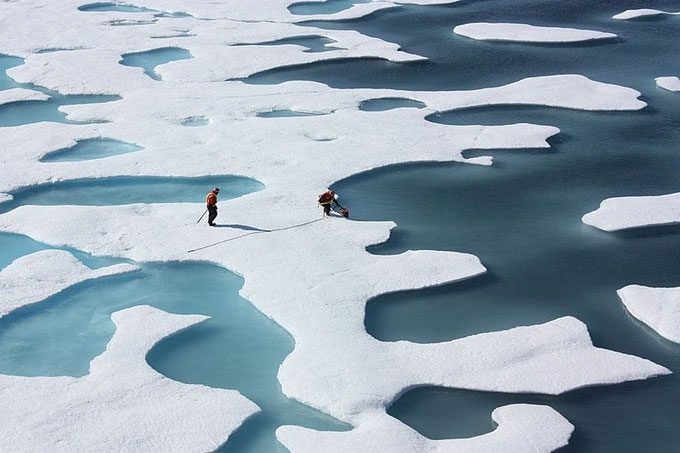Sea ice is frozen seawater that floats on the surface of the ocean, with approximately two-thirds of the Earth’s permanent ice formed in Antarctica and the Arctic.
Despite its vast area, sea ice accounts for only about 1/1,000 of the total volume of ice on Earth.
It is somewhat unique in that sea ice, although made from salty seawater, is almost as pure as freshwater.
Therefore, the production of sea ice is one of the fundamental processes on Earth that regulates the salinity of the oceans.
- When there is more sea ice during cooler global climate periods, the ocean becomes saltier.
- When there is less ice during warmer summer months, freshwater is added to the ocean, reducing the salinity of seawater.
How is Sea Ice Formed?
Seawater freezes at lower temperatures than freshwater due to the presence of salt, with salty water freezing at around -2 degrees Celsius, while freshwater freezes at 0 degrees Celsius.

These freshwater ponds are separated from the salty sea beneath and around them until the ice cracks. (Photo: NASA).
However, due to the relatively low salt content in sea ice, it can be melted and used directly as drinking water.
This is related to the bonds between water molecules and salt.
The presence of salt in ice disrupts the process of ice crystal formation.
In chemistry, salt prefers to bond with water, but water does not.
Consequently, the formation of pure ice necessitates the removal of salt from the ice, requiring colder temperatures to push the salt out of the sea ice crystals.
Once the ocean surface reaches the freezing point of salty water, any cooling will lead to ice formation.
The initial growth of ice is referred to as frazil ice, which consists of small crystal particles and spikes with diameters of up to 3 or 4 mm.
As additional ice crystals develop, they create a “soup” mixture forming on the ocean’s surface.
Once a continuous band of ice is formed, the cold environment is no longer directly connected to the salty water, and sea ice continues to develop by accumulating at its bottom.
In an annual ice cycle in the Arctic, approximately 45 cm of ice melts from the surface while an equivalent amount is added at the bottom.
As a result, an ice crystal that settles in the sea ice at the bottom moves up the ice column at an average speed of about 45 cm/year until it reaches the surface and melts again.
The melting ice causes liquid water to pool in surface depressions, creating melt ponds in the Arctic.
Sea Ice and Ocean Circulation
The salinity of seawater also affects ocean currents. When sea ice grows, most of the salt in the ocean is pushed down into the water beneath the ice cover. The water beneath sea ice is saltier and denser than the surrounding seawater, causing it to sink and flow away from the surface. As a result, sea ice facilitates the circulation of global ocean currents.
Typically, Arctic sea ice reaches its minimum around September, before the end of the summer melt season, and then increases again in winter.
Sea Ice’s Impact on Global Climate
Sea ice is primarily found in polar regions and has a significant impact on global climate.
Their shiny surfaces reflect a lot of sunlight back into space and the atmosphere.
Because this solar energy “returns” instead of being absorbed by the water, temperatures near the poles remain much cooler than at the equator.
When sea ice melts, due to rising temperatures, there is less white surface to reflect sunlight, leading to increased absorption of solar energy and consequently higher water temperatures.
This initiates a cycle of warming and melting, where rising water temperatures cause ice accumulation at the end of winter and faster melting in the following summer.
Even a slight increase in temperature can lead to significant warming over time, making polar regions particularly sensitive to climate change on the planet.


















































